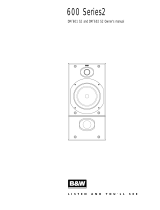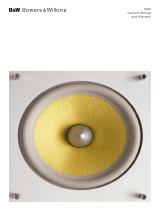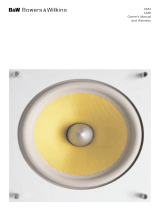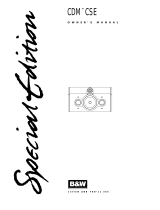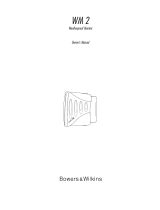1
ENGLISH
INTRODUCTION
Thank you for choosing B&W.
Please read this manual fully before unpacking
and installing the product. It will help you to
optimise its performance.
B&W maintains a network of dedicated
distributors in over 60 countries who will be able
to help you should you have any problems your
dealer cannot resolve.
UNPACKING
(figure 1)
•Fold the carton flaps right back and invert
the carton and contents.
•Lift the carton clear of the contents.
•Remove the inner packing from the product.
We suggest you retain the packing
for future use.
Check in the carton for:
•2 (604)/4 (603) foam plugs.
•4 spike feet with lock nuts.
POSITIONING
(figures 2 & 3)
Do not fit the spike feet until you have found
the best position for your speakers.
As an initial guide (figure 2):
•Position the speakers and the centre of the
listening area approximately at the corners
of an equilateral triangle.
•Keep the speakers at least 1.5m apart
to maintain left-right separation.
•Keep the speaker baffles at least 0.5m clear
of walls.
Stray magnetic fields
The speaker drive units create stray magnetic
fields that extend beyond the boundaries of the
cabinet. We recommend you keep magnetically
sensitive articles (television and computer
screens, computer discs, audio and video tapes,
swipe cards and the like) at least 0.5m from the
speaker.
CONNECTIONS
(figures 4 & 5)
All connections should be made with the
equipment switched off.
There are 2 pairs of terminals at the back of
the speaker which permit bi-wiring if desired.
On delivery, the separate pairs are connected
together with high-quality links for use with a
single 2-core cable. For single cable connection,
leave the links in place and use either pair of
terminals on the speaker (figure 4).
Ensure the positive terminal on the speaker
(marked + and coloured red) is connected
to the positive output terminal of the amplifier
and negative (marked – and coloured black)
to negative. Incorrect connection can result in
poor imaging and loss of bass.
To bi-wire, remove the links by loosening the
terminal caps and use a separate 2-core cable
from the amplifier to each pair of terminals. This
can improve the resolution of low-level detail.
Observe the correct polarity as before. When
bi-wiring, incorrect connection can also impair
the frequency response (figure 5).
Ask your dealer for advice when choosing
cable. Keep the total impedance below the
maximum recommended in the specification and
use a low inductance cable to avoid attenuation
of the highest frequencies.
FINE TUNING
Before fine tuning, double check that all the
connections in the installation are correct and
secure.
Moving the speakers further from the walls will
reduce the general level of bass. Space behind
the speakers also helps to create an impression
of depth. Conversely, moving the speakers closer
to the walls will increase the level of bass.
If you want to reduce the bass level without
moving the speakers further from the wall, fit
the foam bungs in the port tubes (figure 6).
If the bass is uneven with frequency it is usually
due to the excitation of resonance modes in the
room. Even small changes in the position of the
speakers or the listeners can have a profound
effect on how these resonances affect the sound.
Try mounting the speakers along a different wall.
Even moving large pieces of furniture can have
an effect.
If the central image is poor, try moving the
speakers closer together or toeing them in
so they point at or just in front of the listeners.
If the sound is too harsh, increase the amount
of soft furnishing in the room (for example use
heavier curtains), or reduce it if the sound is
dull and lifeless.
Test for flutter echoes by clapping your hands
and listening for rapid repetitions. Reduce them
by the use of irregular shaped surfaces such as
bookshelves and large pieces of furniture.
Ensure the speakers stand firmly on the floor.
Whenever possible fit the spike feet supplied
after you have optimised the positioning. They
are designed to pierce through carpeting to the
floor surface. Initially, screw the lock nuts fully
onto the spikes and screw the spikes fully into
the threaded inserts in the base of the speaker.
If the cabinet rocks, unscrew the appropriate
spikes until the speaker stands firmly on the floor
and lock them in place by tightening the lock
nuts against the base. If you do not have a
carpet, use a protective disc under the spikes
to protect the floor surface.
AFTERCARE
The cabinet surface usually only requires dusting.
If you wish to use an aerosol cleaner, remove
the grille first by gently pulling it away from
the cabinet. Spray onto the cleaning cloth, not
directly onto the cabinet. The grille fabric may
be cleaned with a normal clothes brush whilst
the grille is detached from the cabinet.
Avoid touching the drive unit diaphragms,
especially the tweeter, as damage may result.




